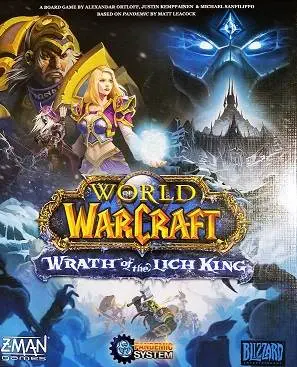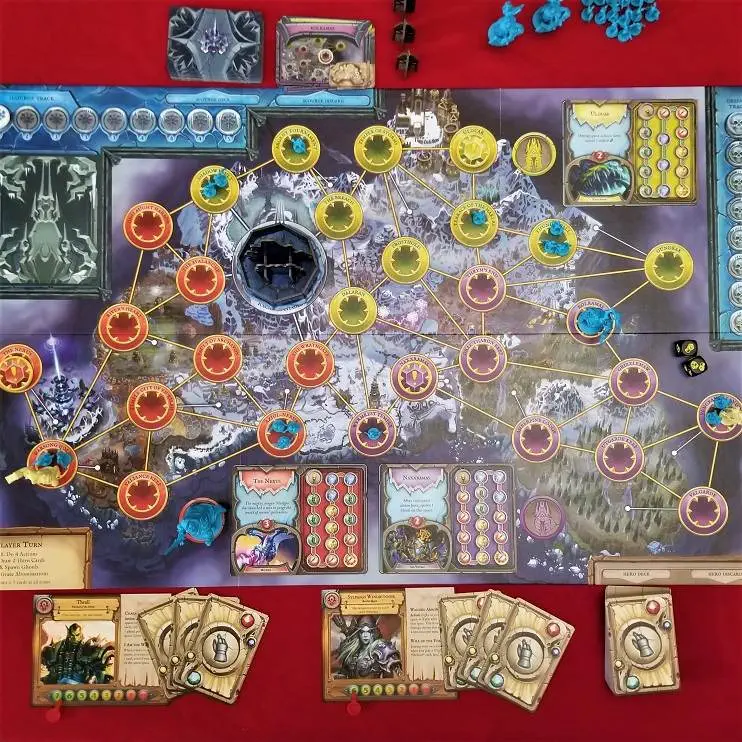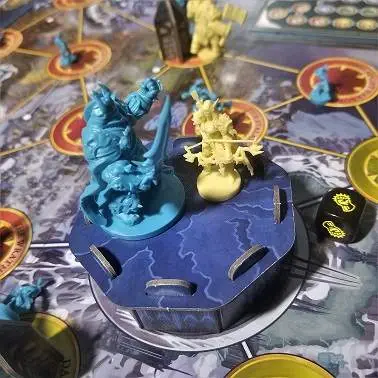
In the icy depths of the far north, an evil stirs. Northrend, the source of the vile Scourge, is a frozen wasteland often overlooked as the Alliance and Horde fight out their own conflicts with one another. Arthas, formerly the Prince of Lordaeron, has taken up the cursed blade Frostmourne and is raising an army that will threaten all of Azeroth. Heroes of both factions will need to band together and make their way through the “roof of the world” should they wish to overcome this rising threat before it reaches a strength that will overtake all in its path.
World of Warcraft: Wrath of the Lich King is the newest release from Z-Man Games using the Pandemic System. Unlike many of the other Pandemic series games, however, Wrath of the Lich King was not designed by Matt Leacock or Thomas Lehmann. Instead, Alexandar Ortloff, Michael Sanfilippo, and Justin Kemppainen combine their experience and skills as game designers to bring the icy realm of Northrend and all the horrors it contained out from the digital world and onto the tabletop. Of course, no game is complete without its art, and Wrath of the Lich King has plenty covering its box, rulebook, and many components. Much of the art was provided by noted board game artist Atha Kanaani, but the game also features contributions from several Blizzard artists. Unlike most previous releases in the Pandemic series, Wrath of the Lich King uses miniatures to represent both the characters and the spreading contagion (in this case, the undead hordes). These miniatures were sculpted by Niklas Norman and Luigi Terzi, both of whom have worked on several games other than this release.

The setup for Wrath of the Lich King had a lot of pros and cons going for it. The rulebook shows a 10-step process, but, really, it is more like two or three times that with all of the little steps in between. Though none of these steps are necessarily difficult, the sheer number of components made it more complicated, a tad bit annoying the first few times we played, and much lengthier than necessary for how easy the game is to learn and play. That being said, the fact that players can choose how easy or difficult to make the game based on their chosen setups is a serious boon as is the amount of variability provided to keep the game fresh. As soon as the board is placed in the play area and populated with quests, rewards, and undead enemies, players are already able to make choices not only about who they wish to play as, but how arduous their siege against the Icecrown Citadel will be. While the quests are meant to be chosen at random, there are certainly some that are harder than others and can be picked on purpose. The real difficulty settings, however, come into play when building the Hero Deck. After players have been dealt their starting hand of cards, the number of “Stronghold” and “Scourge Rises” cards placed within the remaining deck can be increased or decreased based on a table in the rulebook in order to properly scale the difficulty and keep it balanced. All of these options allow players to tailor their experience to suit their tastes once they have played a few games. Once set up, the player who has “ventured furthest north” is declared the first player and the adventure is ready to begin.

Wrath of the Lich King plays much like any of the Pandemic games. Players take turns as they work together to control the state of the board; balancing their efforts between containing the spreading Scourge and completing quests. On a player’s turn, they take four actions. These can include any combination of Move, Quest, Fight, Rest, or Flight Path as well as any special skills their character may have. Each character’s unique abilities differentiate them from each other and are displayed on their card. Some of these aforementioned abilities may take actions to perform while others are simply in effect and will be described in full on a case-by-case basis. There are also several free actions available through the use of cards that can be used at any point during a player’s turn. All of these combine to allow a player to transverse the territories and progress towards their ultimate goal of the Lich King’s demise. After their actions are completed, the player will draw two cards from the Hero deck, resolve any Stronghold or Scourge Rises cards that were drawn, discard down to the hand limit of seven if necessary, spawn new ghouls onto the board, and resolve the actions of any abominations. Play will then progress to the next character. All of this is gone into with more detail in the rulebook, but it is enough to say that with the variable difficulty levels of the game that this can all play out very differently based on which characters were chosen and how far the group wants to press their luck when setting up the game. If ever a hero is reduced to zero health, there are no ghouls to place when one is needed, there are no cards in the Hero deck when they need to be drawn, or a location is overrun with too many ghouls then the despair tracker must be advanced. If the despair tracker reaches the end of its row, the game will end in an immediate loss. To prevent this, players are tasked with completing the three regional quests, pushing Arthas back to his citadel, and then finishing the quest there before being overwhelmed.
Unless you are a diehard WoW fan or just want to try Pandemic in a lesser form with a few twists on the mechanics, we would politely recommend that you skip this one. Already all over the internet people are coming up with additions or tweaks to the game having felt like it didn’t capture the feeling of the video game well enough, wasn’t challenging, or just fell short of their expectations. The minis were a nice touch but with Kickstarter bombarding us with new games on the regular we have learned that you cannot judge a game by its minis: we have bought in on a few that will never see our tables again when we were drawn in by the shinies they drew us in with during their campaigns. World of Warcraft: Wrath of the Lich King is more of the same. It just doesn’t bring back that nostalgic feeling of having fought our way through Arthas’ forces with our guildmates to finally face him in combat in an epic fight to the death. In fact, Board Game Geek patrons have rated this game as best being played alone as a single-player game. After several plays of our own, we found that we would have also liked to see a few things done differently or added to the game. For example, having additional variances on the regional quest cards and final Icecrown Citadel quest, giving the Lich King more direct influence either with actions of his own or something more than just passive damage (especially when in the Citadel), or more interesting effects from the abominations. Presenting these either as updated rules, expansion packs, or even just some widely available promos would allow for the opportunity to greatly improve the overall experience. Pandemic Legacy and Fall of Rome are far more recommended, if you haven’t played them yet, and will present an overall better experience for those not being gulled by WoW colored glasses. If it is the WoW theme or the minis that attracted you to this product then this may be exactly what you are looking for as the art and sculpts are terrifically done and draw you in while playing the game. Overall Wrath of the Lich King isn’t a bad game. We just felt it could have been so much more and look forward to what both the gaming community and Z-man themselves might do with the project in the future.
All photos of Z-Man Games products were taken and edited by Krista.